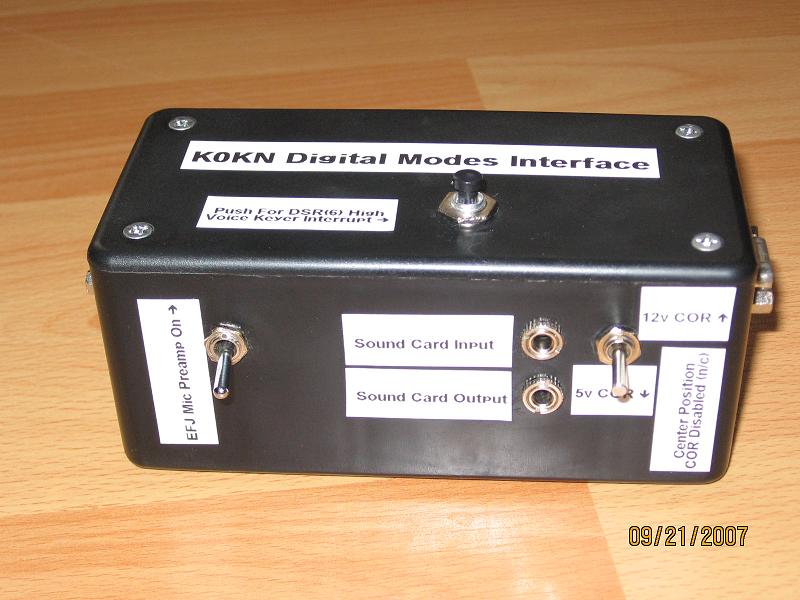
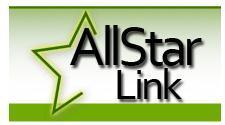
This page has the latest info on my VOIP radio station. See the left side of the page for
other operating modes and projects.
If this is not visable, click here to reload web page.
I discovered Echolink in the Summer of 2005, and have been experimenting with it ever since. After using Windows software, RtpDir, IRLP/EchoIRLP and TheLinkBox, I'm now operating Asterisk/app_rpt software as of 2011.
My registered node numbers are: Allstar-nodes 2210 thru 2219, Echolink 267895(K0KN), 309554 (K0KN-L / Allstar 2213), 307578 (K0KN-R / Allstar 2218)
Background
My Echolink adventure began in 2005 when I was traveling through Austin, Texas and scanning local 440 MHz FM repeaters. I stumbled upon a QSO between a local ham in Austin and a guy in the UK! Once I figured out WHAT I was listening to, I wanted to figure out HOW it worked!
The audio quality was excellent, and all repeater functions worked normally (squelch tail, courtesy tone, etc). The two guys chatted as though they were both in the same town. Of course, the fellow's accent and G3 callsign gave it away.
The more I listened to that repeater, the more excited I became! Using DTMF sequences, these local hams were able to extend the range of their repeater from the Austin metro area to anywhere on earth via Echolink! The DTMF control is very similar to an Autopatch, and allows you to connect to a specific node number, random node, disconnect the link, etc.
I was excited about all of the possibilities! What a great way to stay in touch while traveling! As long as there is an Echolink-enabled repeater where you're going, you can connect via your HT or mobile to those back home (or anywhere else!).
What systems to use? Allstar, Echolink, IRLP?
To be honest, I proceeded with caution, as I'd been discouraged before (with IRLP). IRLP is a similar to Echolink, but not nearly as friendly to install, or operate. For example, IRLP only runs on the Linux operating system and requires that you BUY a proprietary commercial interface - no homebrewing is allowed! IRLP rules aside, you can download a schematic for a compatible interface.
IRLP is only for linking radios together - users are not allowed to connect to the system via SIP/IAX softphones, cell phone APPs or PC software. This is a big drawback for the casual operator. However, the number of registered stations on Echolink is about 300,000 compared to about 2000 on IRLP, so don't worry about it.. hi hi
Echolink and Allstar allow connection via RF, PC software, cell phone APPs, SIP/IAX softphone, Web Transceiver, or even telephone.
IRLP is not helpful to you if the person you want to talk to is not in range of an IRLP node! With Echolink or Allstar, you can connect as a home user without a repeater!
Echolink's home user mode can be useful for many situations. For example, many OMs are in assisted living centers and cannot install antennas of any kind. Maybe you live in a subdivision with an out-of-control Homes Association and are also precluded from installing antennas?
Perhaps you're out of town on business, and don't know which repeaters will be in range, etc? Stay in touch by using Echolink in your hotel room, coffee shop, etc using the Internet.
Echolink will work with dial-up, cable, DSL, Wi-Fi, whatever!
I have learned that IRLP is different from Echolink in other ways. For example, random connects are quite common on Echolink. There is even a list of DTMF commands for "Connect to random repeater or link", "Connect to random conference", "Connect to random user" and so on. Generally speaking, IRLP node owners do not support such activity.
The latest (and greatest) VOIP network out there is
AllStar (read more below)
This network is sometimes referred to as Asterisk, after the open-source Telephone PBX system it's based on. Allstar is the pinnacle of VOIP network development. The Allstar and Asterisk names are used interchangeably.
Allstar has a taken a big technological leap beyond anything else out there. Because it's based on a telephone software system,
it is easily (and seamlessly) integrated with the IAX, SIP or POTS telephone network. Cross-platform support such as
IaxRpt for Windows
is available, and is an easy way to participate on Allstar without a radio.
Getting Started with Echolink
The official Echolink software runs on the Windows platform, and can be operated a couple of different ways. Note that the Echolink software package is exactly the same in all cases. Echolink-compatible packages are available for Linux and Mac.
* Using the normal 'user' mode, you simply sit at your PC and talk into a computer microphone.
* Via repeater. Many repeaters offer Echolink! The access is controlled by the repeater owner, so you may be required to join a club, etc for access.
* Set up your own RF-linked node, or simplex link. This is how I operate 99% of the time. I connect a radio in my shack via homebrew interface to my PC. The interface is basically a PSK31-type sound card interface with a few extra features. This allows me to take Echolink with me where ever I go! I routinely operate while out walking my dog, and have worked stations in Australia, Japan, and all over the US this way.
Asterisk is built on an open-source PBX telephone system, but the folks from AllStar Link have designed a specific Amateur Radio application, called app_rpt. The capabilities of Asterisk surpass anything I've dreamed of in a Ham Radio VOIP system. For example, one PC running Asterisk can control up to 8 separate radio links or repeaters (using a single Internet IP address!)
Allstar Link supports
Web Transceiver, so you can operate Allstar from your PC, without
installing Linux, etc. Sign up for a free account and check it out.
To get started with your own Asterisk node, download the ISO on the Allstar web site, and burn an
Installation CD .
NOTE: The installer will repartition your hard drive and install CentOS 5.1 (Linux) and
Asterisk. The installer does not ask which hard drive to install CentOS to (Most Linux
Installs will!), and the software will be installed to the first hard drive. I lost my Windows XP drive this way!
I hope to QSO with you on Asterisk soon!
Note that as of 2011, no expensive USB fob from overseas needed for Asterisk, just a generic, unmodified CM108 USB fob and IRLP board or Asterisk parallel port interface
Homebrew Echolink / Digital Modes Interface
My PLRI interface was designed to be compatible with this interface.
K0KN Universal Interface Schematic
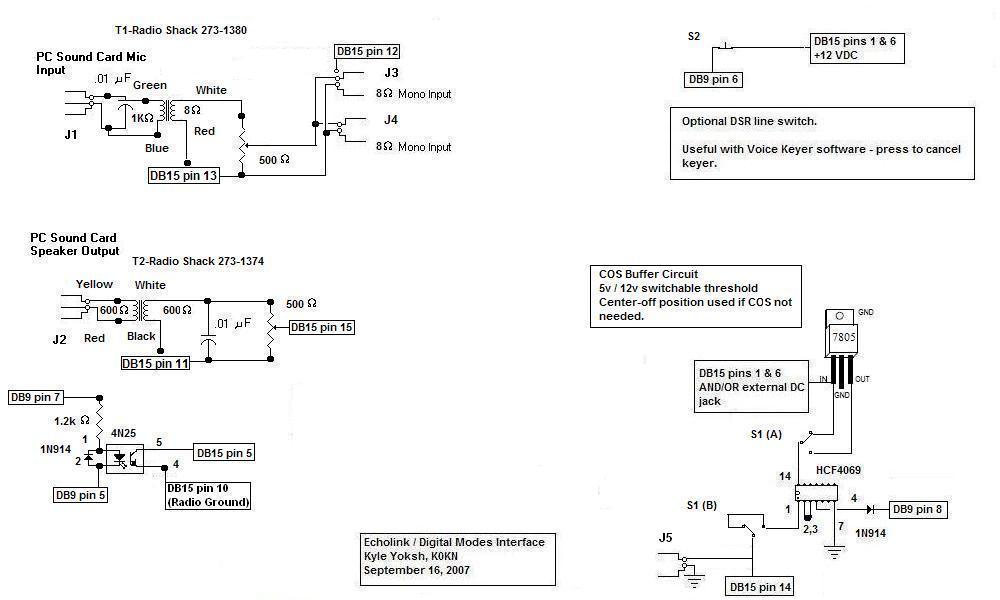
Connector Pinout
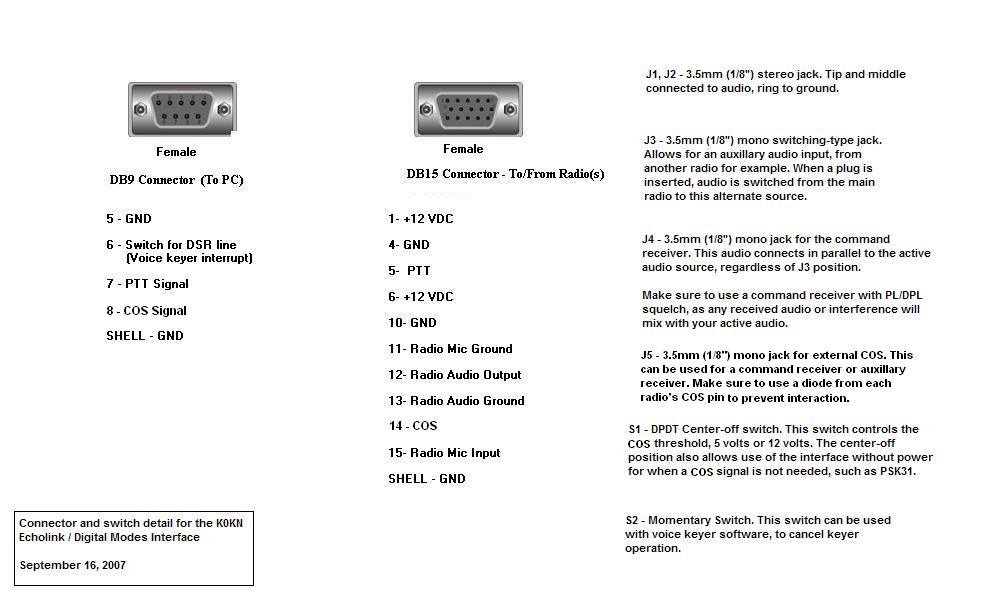
Prototype Echolink/Digital modes interface

K0KN-L Node Hardware
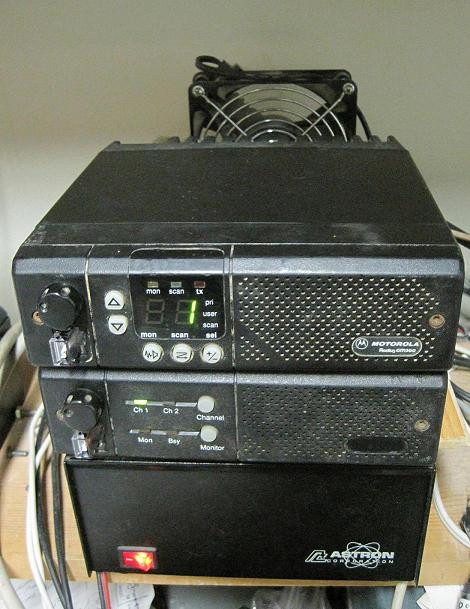 The RF / VOIP gateways at my QTH consist of:
The RF / VOIP gateways at my QTH consist of:
The GM300 VHF radio is capable of 40+ watts output, but I want it to run nice and cool, so it is set at 25 watts output. The Maxtrac UHF radio is capable of 25 watts output, but it is set at 12.5 watts output. There is a large cooling fan aimed at the heatsink of the radios. The fan is controlled by a script called TXFAN that I modified for use with Allstar/Asterisk. The fan is configured to run only after the PTT is keyed for 30 seconds. The fan timer resets with each PTT, and will continue to run for 3 minutes after PTT drops. Activity on any transmitter activates the fan script.
Each radio is a complete, stand-alone RF/VOIP gateway, although any/all radios can be connected via DTMF command to form cross-band repeaters if desired. Command of the node(s) can be performed via any node, which allows control of the link even while it's transmitting. The transmitters can be remotely shut down (Required by FCC regulations), and can also be turned back on remotely.
The VHF node is currently connected to a Ringo Ranger omni at approximately 35 feet, fed with 1/2" heliax. Coverage has been quite good considering the modest antenna and power output. You can expect decent mobile coverage to about 15 miles, depending on terrain. Most of the Olathe / Overland Park area is within mobile range of this node, as is The Kansas Speedway / Legends area of Kansas City, KS. HT coverage is limited to about 2 miles with rubber duck antenna.
The UHF node is connected to a separate 5/8 wave dual-band omni at approximately 30 feet, also fed with 1/2" heliax. You can expect a smaller coverage area due to the increased path loss at UHF.
Another capability of this system is satellite operation. Using node 2214 (Satellite RX-only), stations with a modest setup will be able
to use my station to hear satellites, and use their own HT or mobile to uplink.
There is even a way to use my satellite setup for both uplink/downlink via VOIP links! My station will handle satellite uplink/downlink, rotator movement, doppler correction, etc, and VOIP upstream/downstream.
Please email me with your results also!
73 and good luck!
Kyle
This site requires a frames-compatible browser for proper page viewing. If you're having
trouble viewing this page, or want to visit the non-frames page, click
here